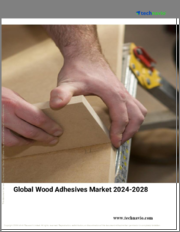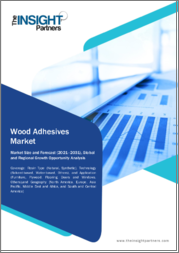
|
시장보고서
상품코드
1557366
세계의 목재 접착제 시장 : 예측(2024-2029년)Wood Adhesives Market - Forecasts from 2024 to 2029 |
||||||
목재 접착제 시장은 2024년에 69억 3,200만 달러로 추정되고, 예측 기간의 CAGR은 6.40%를 나타낼 것으로 전망됩니다.
목재 접착제는 목재 재료를 결합하는 데 사용되는 부품이며 가구 제조 회사에서 주로 사용됩니다. 접착제에 사용되는 새로운 변형과 첨단 기술, 가정용품의 사용량의 급증, 커스터마이즈 가구의 요구 증가, 새로운 접착 기술의 개척 등이 시장 성장을 가속하는 요인이 되고 있습니다.
아메리카 지역은 저비용 목재 접착제의 연구개발에 대한 투자가 증가하고 있기 때문에 큰 시장 점유율을 차지할 것으로 예상됩니다. 아시아태평양은 경제 성장, 주택 수요 증가, 가처분 소득 증가로 인해 큰 성장률을 보입니다.
- 독일의 건축건설 허가건수는 217건, 2022년은 586건, 2023년은 163,906건으로 크게 증가하고 있습니다. 건축에 소비된 예상 비용은 2022년에는 1억 3,499만 유로, 2023년에는 1억 1,299만 2,000유로였습니다.
- 스페인을 방문하는 관광객 수는 2023년에는 85,169,050명, 2022년에는 71,659,281명으로 크게 급증했습니다. 그 결과, 호텔이나 레스토랑 수요가 높아졌습니다.
목재 접착제 시장 성장 촉진요인 :
- 주택부문 수요 증가
주택 부문의 성장은 세계 도시화의 진전과 세계 각지에서의 경제 발전의 확대로 인한 것입니다. 건설 개발의 상당 부분은 주택, 병원, 호텔, 레스토랑, 학교 등 인구를 위한 건축에 소비됩니다. 세계경제포럼에 따르면 총 인구에서 차지하는 도시 인구의 비율은 2022년에는 55%, 2080년에는 80%가 된다고 합니다. 이러한 도시 인구 증가에는 주요 주택을 포함한 다양한 유형의 건물이 필요합니다. 이 인구 증가에 대응하기 위해 세계 각국의 정부는 주택 건설에 자금을 투입하고 있습니다.
예를 들어 캐나다 연방 정부는 2024년 6월 새로운 세대의 공동 주택을 건설하는 15억 달러의 프로그램을 시작했습니다. 이 프로그램은 2028년까지 수천 개의 새로운 코프 주택을 건설할 예정입니다. 이 협동 조합 주택 개발 프로그램은 캐나다에서 저렴한 주택을 늘릴 것입니다. 이러한 건설 부문의 발전은 바닥재, 구조 지지, 디자인, 천장 디자인 등 많은 용도로 목재를 사용하는 것으로 이어질 것입니다.
- 상업건축 부문의 성장
신흥경제국은 상업건설산업의 발전에 큰 역할을 하고 있습니다. 세계 각국은 저렴한 주택, 사무실, 학교, 상업 건물, 행정 건물, 병원 건설에 적극적으로 투자하고 있습니다. 신흥국가에 의한 이러한 개발은 경제 성장을 자극해 제조 및 건설 양 부문에 급속한 고용을 가져옵니다. 아시아와 아프리카의 성장 경제권에서는 상업 공간의 사용이 현저하게 증가하고 있습니다. 상업 공간에서는 미관을 목적으로 목공 세공이 사용되어 한정된 공간에서 더 나은 디자인을 실현하고 있습니다.
또한, 세계 관광 활동의 활성화는 각국의 호텔 및 기타 숙박 시설 증가를 일으키고 있습니다. 연방 통계국에 따르면 2024년 5월 독일의 해외 투숙객 수는 2023년 5월에 비해 3.1% 증가한 750만 명이었습니다. 이 숫자는 팬데믹 후 사람들이 봉쇄 후에 다양한 장소를 방문하려고 하기 때문에 크게 증가했습니다. 세계 상업 부문의 성장은 시장의 목재 수요에 긍정적인 영향을 미칩니다.
- 지속 가능한 재료 이용에 대한 수요 증가
접착제는 목조 건축을 허용함으로써 건축 구조의 지속가능성에 기여합니다. 목재는 천연 소재이기 때문에 합성으로 생산된 소재보다 유익합니다. 목재는 주로 강도, 모양 및 기능을 유지하는 목재 패널에 사용됩니다. 그 때문에 크로스 라미네이션이나 접착제에 의한 라미네이션 등, 다양한 목재의 층이 접착제와 함께 이용됩니다. 이러한 원재료의 사용을 늘림으로써 건축물의 이산화탄소 배출량을 개선할 수 있습니다.
파티클 보드, OSB, 합판, 섬유계 재료 등의 목재 재료는 건설 산업 및 가구 제조에서 지속 가능한 건축 재료로 사용됩니다. 또한 자동차의 구조에도 이용되고 있습니다. 목재 기반 제품은 미래에 큰 역할을 할 수 있으며 목재 접착제 시장을 확대합니다.
목재 접착제 시장의 지리적 전망
- 예측 기간 동안 아시아태평양은 목재 접착제 시장을 독점합니다.
지역별로 보면 북미, 남미, 유럽, 중동, 아프리카, 아시아태평양으로 구분됩니다. 아시아태평양은 중국, 일본, 인도, 한국 등 주요 경제국이 지배적입니다. 이것은 목재가 이용되는 건축과 가구와 같은 1차 산업에서 다양한 원재료에 대한 수요를 야기합니다.
보고서 정보
이 조사 보고서는 수지 유형, 기술, 용도 및 지역과 같은 다양한 부문을 기반으로 시장 세분화 시장을 조사했습니다. 첫째, 간단한 시장 개요는 주요 촉진요인과 과제를 자세히 설명합니다. 그런 다음 Porter's Five Forces 모델에서 목재 접착제 산업을 종합적으로 분석합니다. 이어서 밸류체인 분석이 수행되어 다양한 프로세스에 속하며 다양한 분야에 기여하는 기업이 결정됩니다.
또한 목재 접착제 시장에 영향을 미치는 시장 개척, 동향, 업계 정책 및 정책에 대한 자세한 정보를 제시합니다. 또한, 이 연구는 목재 접착제 분야의 전반적인 규제 프레임워크를 분석하고 시장 환경 전체에 영향을 미치는 주요 요인에 대한 이해관계자들에게 이해를 깊게 하기 위한 것입니다.
목재 접착제 시장의 주요 발전 :
- 2024년 2월 : 독일의 화학 기업인 Henkel과 Covestro는 내력 목조 건축용 접착제를 제조하기 위해 제휴했습니다. 재료 제조업체인 코베스트로가 헨켈에 폴리우레탄 베이스의 원료를 제공해, 바이오 베이스의 원료에 연결하는 것으로, 지속 가능한 접착제가 됩니다.
- 2023년 11월 : Henkel은 내하중 목조 건축용의 최초의 바이오 베이스 PUR 접착제를 발매했습니다. Loctite HB S ECO 및 Loctite CR 821 ECO는 바이오 폴리우레탄(PUR) 접착제로 인증되었습니다. 이 환경 친화적인 재료는 환경 풋 프린트를 더욱 향상시킵니다. CO2 배출량은 화석 유래 버전보다 62% 적습니다.
- 2023년 5월 : Fraunhofer WKI는 LIGNA 2023에서 목재 기반 재료 제조용 포름알데히드 프리 바이오 접착제를 발표했습니다. 이것은 새롭게 개발된 리그닌-HMF 수지로, 지속가능한 목질계 재료로서의 장점이 있습니다. 석유화학적인 축합 수지를 대체하는 바이오 베이스로부터 만들어집니다.
- 2022년 5월 : 세계 유수의 접착제 전문 기업인 보스틱은 새로운 목재 접착제 솔루션을 발표했습니다. 이들은 슈퍼 그립 접착제 솔루션 라인으로 SG6518 및 SG6520으로 명명되었습니다. 슈퍼 그립은 핫멜트 폴리우레탄 리액티브(HMPUR) 접착제 솔루션으로 목공 산업에서 가장자리 밴딩에 사용됩니다.
목재 접착제 시장은 다음과 같이 세분화되고 분석됩니다.
수지 유형별
- 천연
- 동물성
- 식물성
- 합성
- 열경화성
- 열가소성
- 기타
기술별
- 물 베이스
- 용제 베이스
- 기타
용도별
- 합판
- 가구
- 소비재
- 기타
지역별
- 북미
- 미국
- 캐나다
- 멕시코
- 남미
- 브라질
- 아르헨티나
- 기타 남미
- 유럽
- 영국
- 독일
- 프랑스
- 이탈리아
- 스페인
- 기타 남미
- 중동 및 아프리카
- 사우디아라비아
- UAE
- 기타 중동 및 아프리카
- 아시아태평양
- 중국
- 인도
- 일본
- 한국
- 대만
- 태국
- 인도네시아
- 기타 아시아태평양
목차
제1장 서론
- 시장 개요
- 시장의 정의
- 조사 범위
- 시장 세분화
- 통화
- 전제조건
- 기준년 및 예측년의 타임라인
- 이해 관계자에게 있어서의 주요 이점
제2장 조사 방법
- 조사 디자인
- 조사 과정
제3장 주요 요약
- 주요 조사 결과
- 애널리스트 보기
제4장 시장 역학
- 시장 성장 촉진요인
- 주택 부문에서의 수요 증가
- 성장하는 상업건설 부문
- 시장 성장 억제요인
- 원재료 가격 변동
- Porter's Five Forces 분석
- 업계 밸류체인 분석
제5장 목재 접착제 시장 : 수지 유형별
- 서문
- 천연
- 동물 유래
- 식물 유래
- 합성
- 열경화성
- 열가소성
- 기타
제6장 목재 접착제 시장 : 기술별
- 서문
- 물 베이스
- 용제 베이스
- 기타
제7장 목재 접착제 시장 : 용도별
- 서문
- 합판
- 가구
- 소비재
- 기타
제8장 목재 접착제 시장 : 지역별
- 세계 개요
- 북미
- 미국
- 캐나다
- 멕시코
- 남미
- 브라질
- 아르헨티나
- 기타 남미
- 유럽
- 영국
- 독일
- 프랑스
- 이탈리아
- 스페인
- 기타 유럽
- 중동 및 아프리카
- 사우디아라비아
- 아랍에미리트(UAE)
- 기타 중동 및 아프리카
- 아시아태평양
- 중국
- 인도
- 일본
- 한국
- 대만
- 태국
- 인도네시아
- 기타 아시아태평양
제9장 경쟁 환경 및 분석
- 주요 기업 및 전략 분석
- 시장 점유율 분석
- 합병, 인수, 합의 및 협업
- 경쟁 대시보드
제10장 기업 프로파일
- HB Fuller
- Henkel AG & Co., KGaA
- Bostik SA
- 3M
- Sika AG
- Ashland, Inc.
- Pidilite Industries Ltd.
- Jubilant Industries Ltd.
- AkzoNobel NV
- Franklin Adhesives & Polymers.
- DowDuPont Inc.
The wood adhesives market is valued at US$6.932 billion in 2024 and is projected to grow at a CAGR of 6.40% over the forecast period.
Wood Adhesives are components used to bind wooden materials and are majorly used by furniture manufacturing companies. New variants and advanced technologies being used in glues, a rapid increase in the usage of household items, increasing customized furniture needs, and the development of new bonding technologies are the factors driving the market growth.
The Americas region is expected to have a major market share due to increasing investments in the research and development of low-cost wood adhesives. The Asia Pacific region will have a significant growth rate due to the growing economy, rising demand for housing, and increased disposable income.
- The building construction permits in Germany have been significantly high in 217, 586 in 2022, and 163,906 in 2023. The estimated cost spent for the structure was 134,990 thousand Euros in 2022 and 112,992 thousand Euros in 2023.
- The number of tourists visiting Spain was 85,169,050 in 2023 and 71,659,281 in 2022, a significant jump. This resulted in the demand for more hotels and restaurants.
WOOD ADHESIVES MARKET DRIVERS:
- Increasing demand from the residential sector
The growth in the residential sector is due to the growing urbanization worldwide and growing economic development in different parts of the world. A significant part of the development of construction goes for the building of houses, hospitals, hotels, restaurants, schools, etc., for the population. According to the World Economic Forum, the share of the urban population of the total population is 55% in 2022 and likely to be 80% by 2080. These increased urban population setups needed different varieties of buildings, including the major residential buildings. To accommodate this rising population, governments worldwide are investing funds in the construction of the residential sector.
Such as the Federal government in Canada launched a $1.5 billion program to build a new generation of co?op housing in June 2024. The program will build thousands of new co-op homes by 2028. This Co-operative Housing Development Program would increase the number of affordable homes in Canada. These developments in the construction sector would lead to the usage of wood for many purposes like flooring, structural support, designs, ceiling designs, etc.
- Growing commercial construction sector
The growth of the economies has a significant role in developing the commercial construction industry. Countries worldwide are willing to invest heavily in making affordable housing, offices, schools, commercial buildings, administrative buildings, and hospitals. These developments by the countries stimulate economic growth and provide rapid employment in both the manufacturing and construction sectors. The use of commercial spaces has been significantly rising in the growing economies of Asia and Africa. The commercial spaces use wooden work for aesthetic purposes and accommodate better design in the limited space.
Additionally, the increasing tourism activity worldwide also causes an increase in hotels and other staying facilities in the countries. According to the Federal Statistical Office, the number of overnight stays by guests from abroad in Germany has increased by 3.1% to 7.5 million in May 2024 compared to May 2023. This number has significantly increased after the pandemic as people are willing to visit different places after the lockdown. The growth of the commercial sector worldwide has a positive effect on the demand for wood in the market.
- Rising demand for sustainable material use
Adhesives contribute to the sustainability of building structures by enabling timber construction. Since timber is a natural material, it is beneficial over the most synthetically produced materials. Wood is mostly utilized by wood panels that maintain strength, form, and functionality. Thus, different layers of wood, like cross-lamination or glue-lamination, are utilized with adhesives. By increasing the use of such raw materials, the carbon footprint of buildings can be improved.
Wood-based materials such as particle board, OSB, plywood, or fiber-based materials are utilized for sustainable building materials in the construction industry and furniture production. They are also utilized in vehicle construction. Wood-based products could play a significantly greater role in the future, thus increasing the wood adhesives market.
Wood Adhesives Market Geographical Outlook
- The Asia Pacific region will dominate the wood adhesives market during the forecast period.
By geography, the market is segmented into North America, South America, Europe, the Middle East and Africa, and Asia Pacific. The major economies like China, Japan, India, and South Korea dominate the Asia-Pacific region. This causes demand for various raw materials in primary industries like construction and furniture, where wood is utilized.
About Report
This research study examines the wood adhesives market based on various segments: resin type, technology, application, and geography. First, a brief market overview details key driving factors and challenges. Next, Porter's five forces model analyzes the wood adhesives industry comprehensively. This is followed by industry value chain analysis which determines the companies that are part of the different processes and contributing to various sectors.
The study also presents in-depth information concerning the development, trends, and industry policies and regulations affecting the wood adhesives market. Moreover, the research study analyzes the overall regulatory framework of the wood adhesives sector, offering stakeholders a better understanding of the key factors influencing the overall market environment.
Wood adhesives market key developments:
- In February 2024, German chemical companies Henkel and Covestro joined hands to make adhesives in load-bearing timber construction. These would be sustainable as materials manufacturer Covestro provides Henkel with polyurethane-based raw materials linked to bio-based feedstocks. Collaboration would enable a circular and climate-neutrality for both companies.
- In November 2023, Henkel launched the first bio-based PUR adhesives for load-bearing timber construction. Loctite HB S ECO and Loctite CR 821 ECO would be certified polyurethane (PUR) adhesives as bio-based variants. This ecologically friendly material variant additionally improves the environmental footprint: CO2 emissions are 62 percent lower than those of a fossil-based version. The product was developed with 71 percent bio-based materials.
- In May 2023, Fraunhofer WKI presented a formaldehyde-free bioadhesive for the production of wood-based materials at LIGNA 2023. It is a newly developed lignin-HMF resin with advantages as a sustainable wood-based material. It is made from a bio-based alternative to petrochemical condensation resins. Furthermore, by using this substance, wood-based materials would contain only extremely low levels of formaldehyde, which occurs naturally.
- In May 2022, Bostik, a leading global adhesive specialist, launched new adhesive solutions for woodworking. These are under its Supergrip adhesive solutions line, named SG6518 and SG6520. Supergrip is utilized as the Hot-Melt Polyurethane Reactive (HMPUR) adhesive solution to produce edge banding in the woodworking industry.
The wood adhesives market is segmented and analyzed as follows:
By Resin Type
- Natural
- Animal Based
- Plant-Based
- Synthetic
- Thermosetting
- Thermoplastic
- Others
By Technology
- Water Based
- Solvent Based
- Others
By Application
- Plywood
- Furniture
- Consumer Goods
- Others
By Geography
- North America
- USA
- Canada
- Mexico
- South America
- Brazil
- Argentina
- Rest of South America
- Europe
- United Kingdom
- Germany
- France
- Italy
- Spain
- Rest of Europe
- Middle East and Africa
- Saudi Arabia
- UAE
- Rest of the Middle East and Africa
- Asia Pacific
- China
- India
- Japan
- South Korea
- Taiwan
- Thailand
- Indonesia
- Rest of Asia-Pacific
TABLE OF CONTENTS
1. INTRODUCTION
- 1.1. Market Overview
- 1.2. Market Definition
- 1.3. Scope of the Study
- 1.4. Market Segmentation
- 1.5. Currency
- 1.6. Assumptions
- 1.7. Base and Forecast Years Timeline
- 1.8. Key benefits for the stakeholders
2. RESEARCH METHODOLOGY
- 2.1. Research Design
- 2.2. Research Process
3. EXECUTIVE SUMMARY
- 3.1. Key Findings
- 3.2. Analyst View
4. MARKET DYNAMICS
- 4.1. Market Drivers
- 4.1.1. Increasing demand from the residential sector
- 4.1.2. Growing commercial construction sector
- 4.2. Market Restraints
- 4.2.1. Price fluctuations in the raw materials
- 4.3. Porter's Five Forces Analysis
- 4.3.1. Bargaining Power of Suppliers
- 4.3.2. Bargaining Power of Buyers
- 4.3.3. The Threat of New Entrants
- 4.3.4. Threat of Substitutes
- 4.3.5. Competitive Rivalry in the Industry
- 4.4. Industry Value Chain Analysis
5. WOOD ADHESIVES MARKET BY RESIN TYPE
- 5.1. Introduction
- 5.2. Natural
- 5.3. Animal Based
- 5.4. Plant-Based
- 5.5. Synthetic
- 5.6. Thermosetting
- 5.7. Thermoplastic
- 5.8. Others
6. WOOD ADHESIVES MARKET BY TECHNOLOGY
- 6.1. Introduction
- 6.2. Water Based
- 6.3. Solvent Based
- 6.4. Others
7. WOOD ADHESIVES MARKET BY APPLICATION
- 7.1. Introduction
- 7.2. Plywood
- 7.3. Furniture
- 7.4. Consumer Goods
- 7.5. Others
8. WOOD ADHESIVES MARKET BY GEOGRAPHY
- 8.1. Global Overview
- 8.2. North America
- 8.2.1. United States
- 8.2.2. Canada
- 8.2.3. Mexico
- 8.3. South America
- 8.3.1. Brazil
- 8.3.2. Argentina
- 8.3.3. Rest of South America
- 8.4. Europe
- 8.4.1. United Kingdom
- 8.4.2. Germany
- 8.4.3. France
- 8.4.4. Italy
- 8.4.5. Spain
- 8.4.6. Rest of Europe
- 8.5. Middle East and Africa
- 8.5.1. Saudi Arabia
- 8.5.2. United Arab Emirates
- 8.5.3. Rest of the Middle East and Africa
- 8.6. Asia-Pacific
- 8.6.1. China
- 8.6.2. India
- 8.6.3. Japan
- 8.6.4. South Korea
- 8.6.5. Taiwan
- 8.6.6. Thailand
- 8.6.7. Indonesia
- 8.6.8. Rest of Asia-Pacific
9. COMPETITIVE ENVIRONMENT AND ANALYSIS
- 9.1. Major Players and Strategy Analysis
- 9.2. Market Share Analysis
- 9.3. Mergers, Acquisitions, Agreements, and Collaborations
- 9.4. Competitive Dashboard
10. COMPANY PROFILES
- 10.1. H.B. Fuller
- 10.2. Henkel AG & Co., KGaA
- 10.3. Bostik S.A.
- 10.4. 3M
- 10.5. Sika AG
- 10.6. Ashland, Inc.
- 10.7. Pidilite Industries Ltd.
- 10.8. Jubilant Industries Ltd.
- 10.9. AkzoNobel N.V.
- 10.10. Franklin Adhesives & Polymers.
- 10.11. DowDuPont Inc.



















